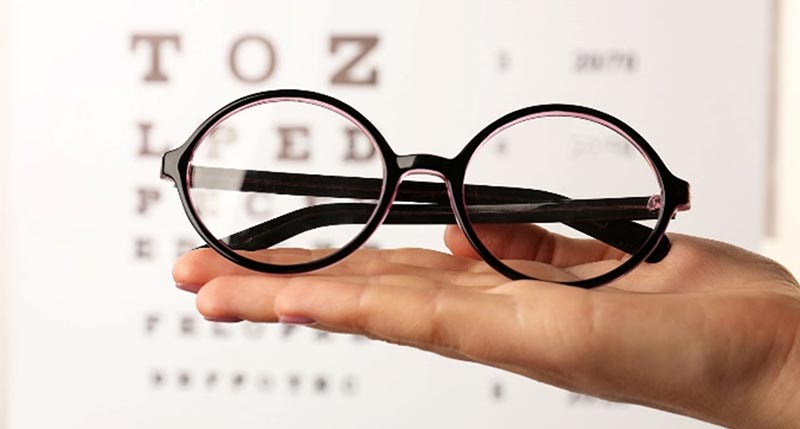Eyeglasses are an amazing invention, aren’t they? For centuries, prescription lenses have helped to restore people’s vision and protect their eyes from damage caused by the sun’s ultraviolet radiation and glare, in addition to blue light that comes from electronic devices.
Have you ever wondered where eyeglass lenses originated and how they are made?
Today’s fashion eyewear has come a long way from its origins. While their exact origin is a bit blurry (pun intended), there are early Greek texts that reference “reading stones” in the 9th century. Somewhere around the year 1280 in Italy, the first pair of corrective lenses were worn. They looked quite different from today’s sleek lenses: They were basically two magnifying glasses made from transparent quartz and crystal (reading stones) in a metal frame that connected across the bridge of the nose by a hinge.
Eventually, glass lenses replaced quartz and beryl lenses. Scientists (in hindsight, we might call them the world’s first optometrists!) found that a convex lens could help correct farsightedness while concave lenses could help correct nearsightedness. Soon, we discovered even more sophisticated lenses to correct the vision of people with astigmatism.
In the early 1950s, plastic polycarbonate lenses were developed, and quickly gained wide acceptance because they were lighter than glass lenses and less likely to break. Although plastic eyeglass lenses are now far more prevalent than glass lenses, both are still used, and the process for making the lenses has remained relatively unchanged.
It all starts with getting the right prescription. When you visit your optometrist for a comprehensive eye exam and find that you need corrective lenses, your optical prescription will include the following values:
- Spherical base strength: Either a positive or negative number that indicates farsightedness or nearsightedness
- Cylinder base strength: Either a positive or negative number that measures the degree of astigmatism
- Axis: The number from 0 to 180 degrees that indicates the orientation of any astigmatism
Your corrective lenses will be made to the exact specifications of your unique optical prescription. The steps to make your prescription eyewear include:
Lens Blanks
Prefabricated “lens blanks” are round pieces of polycarbonate plastic used to make corrective lenses. High-tech laboratories manufacture lens blanks with every possible optical prescription already “built into” them. The thickness and shape of each lens blank, along with its degree and orientation of curves, combine to achieve its optical power. One side of each lens blank is curved, while the other side is flat. Lens blanks are made with varying amounts of existing curvature that exactly correspond with a patient’s optical prescription.
Lens Cutting
When making your corrective lenses, a lensometer is used to mark the “optical center” of the lens blank — the exact point of the blank that will sit directly over your pupil. Then each lens is taped to prevent scratches during the grinding and blocking phases. A grinding machine grinds the flat side of the lens into the correct shape to fit the frame.
Lens Edging
After the lens has been cut, it must be edged to fit into the frame you selected. This involves smoothing and polishing the edges of the lens to ensure a perfect fit. Edging is done using specialized equipment that grinds the edges of the lens to the precise shape required for the frame.
Lens Coating
Many prescription lenses are coated to improve their durability, clarity, and resistance to scratches and glare. Coatings can include anti-reflective coatings, scratch-resistant coatings, and UV protection coatings. Coatings are applied to the surface of the lens using a vacuum deposition process that involves heating the lens material and applying a thin layer of coating material.
Lens Tinting
Some prescription lenses are tinted to provide additional protection from the sun or to enhance visual acuity in specific situations. Tinting can be achieved in several ways, including adding colorants to the lens material, applying tinted coatings, or using specialized tints that are integrated into the lens during the manufacturing process.
Lens Fitting
Once the lens has been cut, edged, coated, and tinted (if necessary), it can be fitted into the frame. The frame must be carefully adjusted to ensure that the lens sits correctly in front of the eye. This involves making adjustments to the nose pads, temple arms, and other parts of the frame to ensure a comfortable and secure fit.
Frame Fitting
When you come to pick up your glasses in our office, we will provide an optical fitting to ensure that the frame fits your face comfortably and that the center point of the lens is precisely aligned with your pupil. This ensures that you will see your best in your sleek, new eyewear. And you’ll look great, too!
Now that you know the process for making corrective eyeglasses, is it time for you to schedule your annual eye exam so we can make a unique pair of prescription eyewear for you?
Making you look good and helping you see your best isn’t just our job – it’s our passion!
Call us today to book your appointment. We’ll make sure your eyes are properly outfitted to enjoy clear, precise vision in your new prescription glasses and prescription sunglasses.

Recent Comments